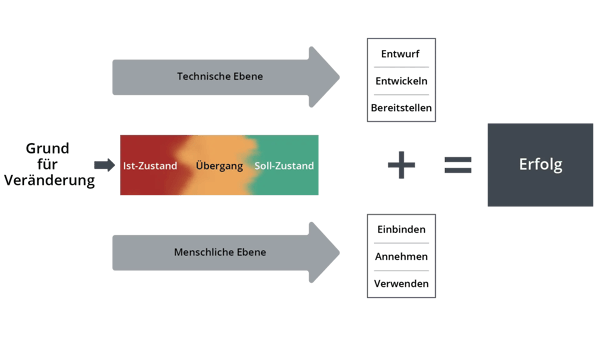What CFOs Need to Know Before Selecting ERP Systems

5 Mins
Updated: August 13, 2025
Published: November 15, 2023

In the rush of decision-making and daily operations, it can be easy to focus solely on the technical aspects of implementing an Enterprise Resource Planning (ERP) system. Although it is a strategic priority for many CFOs, implementing a cloud-based ERP system requires far more consideration than installing the system. To get the full value from your investment, it pays to start with the end users.
ERP Change Management
Our research at Prosci shows that the success of technology projects, including ERP software implementations, is equally dependent on the people navigating, adopting and using the technology. Selecting the right platform is, of course, an essential step. But before you jump into analyzing business requirements, leadership support, user support, functional requirements, and other typical considerations when selecting an ERP tool, it’s critical to consider organizational change management—the people side of the change.
1. Ensure alignment around reasons for the ERP system change
As a CFO, the best first step you can take in the process is to ask questions about business objectives. What are the business reasons for implementing the change? Why are you looking at an ERP system in the first place? What do you want to accomplish for your organization? Are you trying to increase efficiency, provide greater visibility, and uncover analytics to make better business decisions? Are you trying to refine processes? You need to understand precisely what value you want the system to bring to the organization, and to hold the project team accountable to reaching those objectives.
Now, calculate the people-side contribution to ROI. What percentage of the ERP project’s ROI depends on people adopting and using the new tool? It is 70% 80%? More?
This calculation is often overlooked but it ties directly to your business objectives. To realize the ERP system’s full ROI, people must adopt and use the tool in their daily work. This is the people-dependent portion of ROI, the portion of ROI that organizational change management helps you to protect.
Once the leadership team understands the reasons for the ERP system implementation, make sure those reasons are well understood and agreed upon by everyone involved. This alignment is crucial if you’re all going to sing the same tune. Who should be part of this conversation? Key players such as human resources business partners (HRBP), project management, senior leaders, finance, Lean Six Sigma or process team, strategy team or the transformation office, and change management partners should be at the table.
You may also need to consider stakeholders outside the organization like credit card vendors who will need to do something a different way. Customers also need attention because their invoices may now be different, or they may have a new way to access their account and pay their bill.
And all of this should happen before selecting an ERP tool or implementation partner.
2. Understand total costs of an ERP system change
As a CFO, your budget must consider not just the cost of the software, but also the cost of bringing that software into your organization and what it takes to get your organization ready to adopt and use it. Total upfront costs should include:
Defining and documenting processes
Has your organization clearly defined the current state of your processes? Many organizations have not. You need to invest time up front documenting the processes to show how the organization and people will need to change the way they work when you bring in the new ERP technology. And don’t forget the documentation work. Processes exist only in someone’s head until they describe and document them.
Prioritizing project time from employees and internal resources
An ERP system is a significant investment that must provide value back to the organization, but we often see people having to do their full-time jobs while supporting the ERP system implementation. To ensure the expected outcome and benefits, the project must be prioritized, and people need time away from their current job to work on it.
Engaging with, preparing and equipping people for the change
Invest in the right change management resources to help your organization move from the current state to the desired future state. Our experience shows that rework and higher costs result when clients bring in change management after the organization has already chosen an implementation partner that is not equipped to manage the people side of change effectively.
States of Change

Failing to equip people for the change creates a bumpy transition and a "Swiss cheese" future state.
3. Integrate processes and people
For any significant initiative to succeed, we need people to work together, avoiding the creation of silos and rework that diminishes the ROI, expands scope, and extends project timelines. It's not sufficient for a project manager to integrate communications and training with separate workstreams. For the change to be effective, all aspects of the people side of change need to be integrated with the entire strategy and project plan from the very beginning to achieve success.
Unified Value Proposition

Integration creates a unified value proposition to deliver successful change.
4. Uncover impacts from an ERP system change
Understanding the impact of change on people and addressing it early leads to trust in the organization and engagement in the change, especially if your organization has experienced failures in the past. The impacts of an ERP system implementation will be felt across the organization in many areas, from systems and processes to mindsets and beliefs.
10 Aspects of Change Impact

And resistance to change will occur because it’s how people naturally respond to change. Many will exhibit some form of resistance behaviors, and those who struggle most will need help to overcome their barriers. Identifying and understanding impacts helps you prepare people for the change, mitigate and resolve resistance, and ensure readiness when the system reaches go-live.
Many organizations underestimate the mindset shift that is required in moving to an ERP system. We commonly see employees struggle in moving to a self-service model, especially when they are accustomed to receiving their key information and reports from others.
The Critical Mistake CFOs Make
With ERP Systems
As mentioned earlier, the mistake leaders so often make is relying too heavily on communications and functional training, without considering what happens to people and processes when you introduce a massive technology project like an ERP system migration or implementation.
Implementing a new ERP system is such a disruptive change that it's almost like replacing the organization’s nervous system. It changes the way people think, process information, and do their jobs. And it’s often one change among many happening in your organization. It’s not just a technology change.
This is why the people side of change needs to be considered before bringing in an implementation partner. If you don't have a vendor that's going to look at the changes completely and across the board, it's easy for them to blame failure on the training. But the truth is usually that the organization didn’t do what was needed to equip people leaders with the right skills at the right time to help their teams understand what's going to change, prepare them for the new mindset, and support them through their transitions.
Benefits of ERP Change Management
Our correlation research on change management best practices shows that projects with excellent change management are seven times more likely to succeed than projects with poor change management.
Correlation of Change Management Effectiveness With Meeting Objectives

Focusing on the people side of the change goes a long way toward building trust with people in an organization. Even though it's a very difficult transition, they feel like they have support. They feel like somebody has their back. They feel heard and cared for. This is especially important if you have been through unsuccessful changes in the past because people remember. In fact, failed changes are a common root cause of resistance.
Unlike a communications-and-training approach to change management, we build strategies that prepare not only the user population, but also the sponsors, people leaders, project managers and other stakeholders. We ensure that you have a change agent network of internal resources to help support the change. We don’t just send a communication to tell people to be ready for training on a certain day. Ours is a very conscientious approach to understand how we can leverage all the resources in your organization to give everyone what they need in the way they need it, so they’re prepared and ready at go-live.
Unfortunately, ERP systems projects suffer consequences, including budget overruns, delays and outright failures when organizations overlook change management. Some organizations bring us into the project when they realize they need more than communications and training. When we start at this later stage, we mitigate the consequences by backtracking and gauging the gap. Then we partner with the internal change resources or the implementation partner or the project teams to really define the change journey for all the impacted people and teams, and build the right roadmap to help the organization be successful.
Consider Change Management
Before ERP Tool Selection
So, what steps should you take now if you are planning for an ERP systems migration or implementation? Start thinking about people-side impacts and costs early on—well before selecting an ERP software or implementation partner—and identify who your change management partners will be. Discuss integration and how to prevent the formation of silos, and then double down on preparing, equipping and supporting people on their change journeys. The success of your ERP system (and realizing project ROI) depends heavily on people effectively utilizing your new technology, as well as their understanding and acceptance of any process changes the technology will support.




